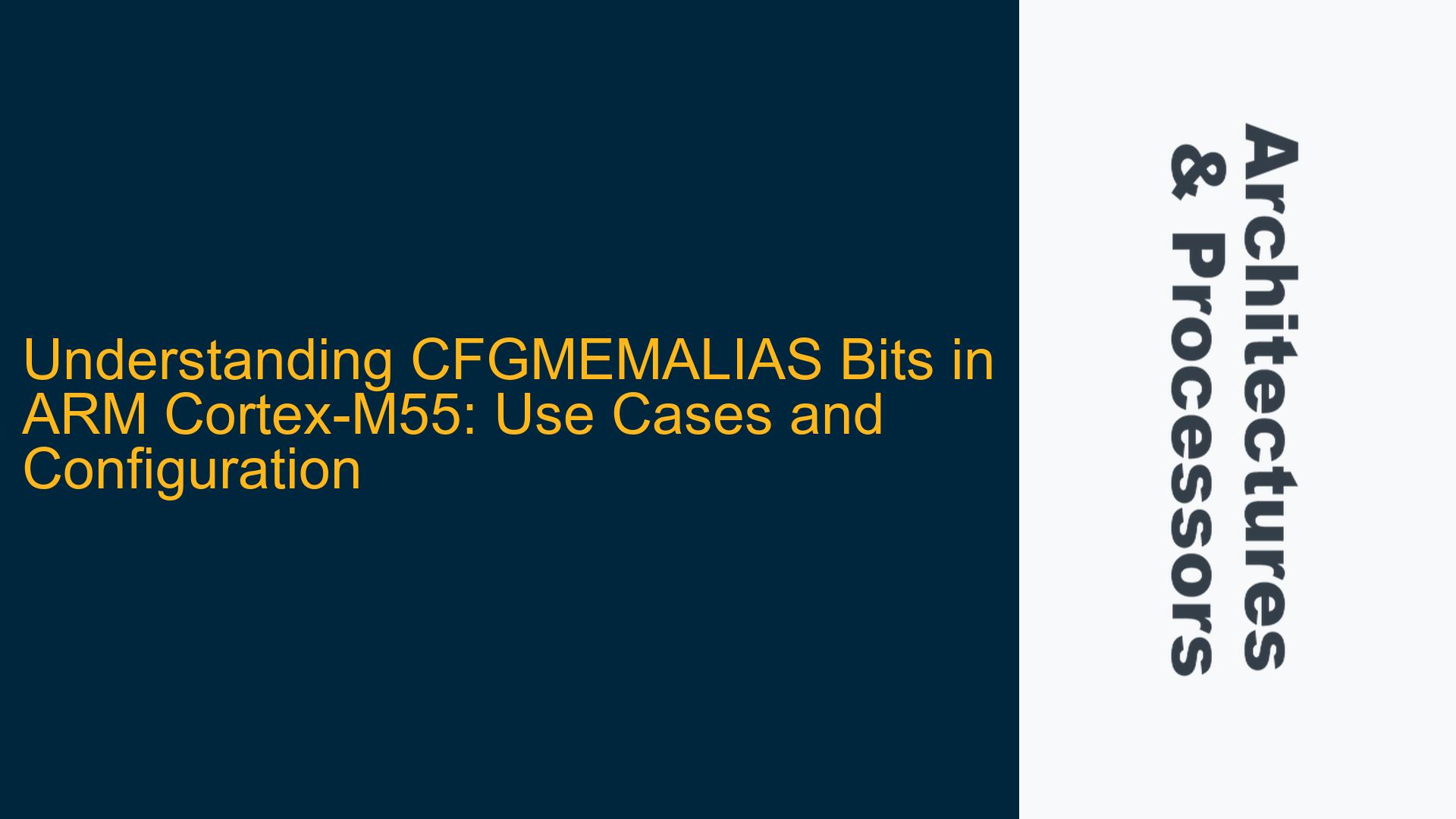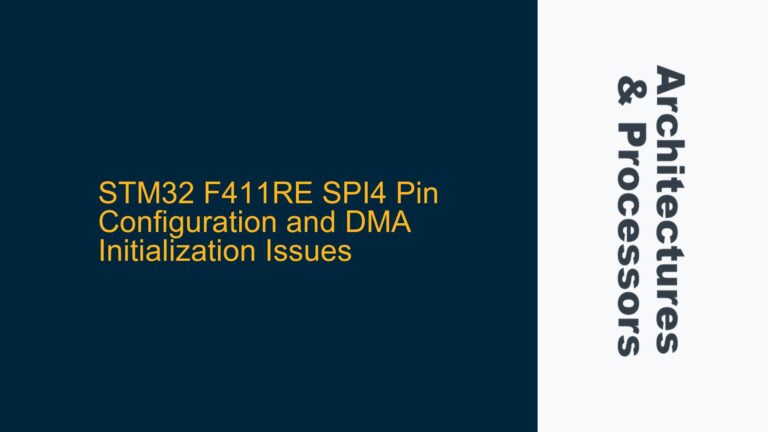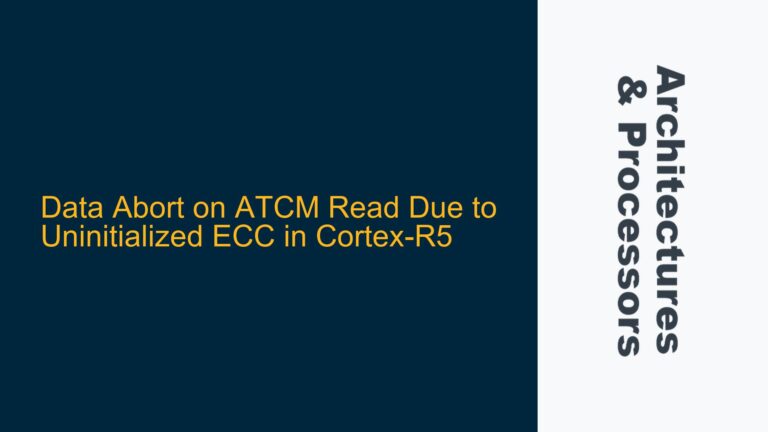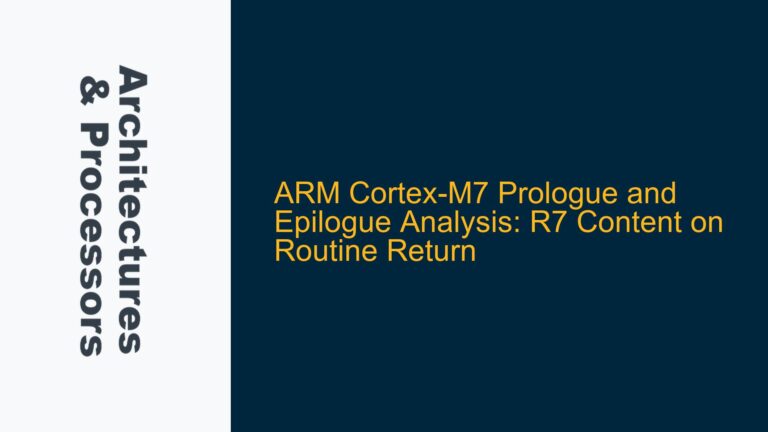CFGMEMALIAS Bits and Their Role in Cortex-M55 Memory System Configuration
The CFGMEMALIAS bits in the ARM Cortex-M55 processor are a critical part of the memory system configuration, enabling fine-grained control over how memory regions are aliased and accessed. These bits are typically found in the System Control Block (SCB) or Memory Protection Unit (MPU) registers, depending on the specific implementation. The primary purpose of the CFGMEMALIAS bits is to define memory aliasing behavior, which allows multiple memory addresses to map to the same physical memory location. This feature is particularly useful in embedded systems where memory resources are limited, and efficient memory utilization is paramount.
Memory aliasing is a technique where a single physical memory block can be accessed through multiple logical addresses. This is achieved by configuring the CFGMEMALIAS bits to define the base address and the range of the aliased memory region. For example, in a Cortex-M55 system, a memory block located at physical address 0x20000000 could be aliased to appear at 0x30000000, allowing software to access the same memory using either address. This capability is especially beneficial in scenarios where different software components or peripherals expect memory to be located at specific addresses.
The CFGMEMALIAS bits are typically organized into fields that specify the base address of the aliased region, the size of the region, and the attributes of the aliased memory (e.g., cacheability, shareability, and access permissions). These attributes ensure that the aliased memory behaves consistently with the rest of the memory system, preventing issues such as data corruption or unexpected behavior due to mismatched memory attributes.
In the Cortex-M55, the CFGMEMALIAS bits are often used in conjunction with the MPU to enforce memory protection policies. By configuring the MPU regions and the CFGMEMALIAS bits, developers can create complex memory layouts that balance performance, security, and resource utilization. For instance, a secure application might use CFGMEMALIAS to create a secure memory region that is only accessible to trusted software, while an unprivileged application accesses a non-secure alias of the same memory.
Understanding the CFGMEMALIAS bits requires a deep dive into the Cortex-M55 memory architecture. The Cortex-M55 implements a Harvard architecture with separate instruction and data buses, which allows for simultaneous access to instruction and data memory. The CFGMEMALIAS bits play a crucial role in managing the memory map, ensuring that aliased regions are correctly mapped and accessed by the processor and peripherals.
One of the key challenges in working with CFGMEMALIAS bits is ensuring that the aliased memory regions do not overlap or conflict with other memory regions. This requires careful planning and configuration of the memory map, taking into account the requirements of the software and peripherals. Additionally, the CFGMEMALIAS bits must be configured in a way that aligns with the overall system design, including the use of caches, DMA controllers, and other memory-mapped peripherals.
In summary, the CFGMEMALIAS bits in the Cortex-M55 provide a powerful mechanism for memory aliasing, enabling efficient use of memory resources and flexible memory system configuration. However, their use requires a thorough understanding of the Cortex-M55 memory architecture and careful consideration of the system design to avoid conflicts and ensure correct operation.
Misconfiguration of CFGMEMALIAS Bits Leading to Memory Access Issues
Misconfiguration of the CFGMEMALIAS bits in the Cortex-M55 can lead to a variety of memory access issues, ranging from subtle data corruption to complete system failure. One common cause of such issues is incorrect specification of the base address or size of the aliased memory region. If the base address is set incorrectly, the processor may attempt to access memory outside the intended region, leading to undefined behavior or memory faults. Similarly, if the size of the aliased region is not properly configured, it may overlap with other memory regions, causing conflicts and data corruption.
Another potential cause of issues is mismatched memory attributes between the aliased region and the original memory region. The CFGMEMALIAS bits allow developers to specify attributes such as cacheability, shareability, and access permissions for the aliased region. If these attributes do not match those of the original memory region, it can lead to inconsistent behavior. For example, if the original memory region is cacheable but the aliased region is configured as non-cacheable, the processor may access stale data from the cache, leading to incorrect results.
Timing issues can also arise from improper configuration of the CFGMEMALIAS bits. In systems with caches or DMA controllers, the timing of memory accesses can be critical. If the CFGMEMALIAS bits are not configured to account for the timing requirements of these components, it can lead to race conditions or data corruption. For instance, if a DMA controller is programmed to transfer data to an aliased memory region, but the CFGMEMALIAS bits are not configured to ensure proper synchronization, the DMA transfer may overwrite data before it is processed by the processor.
In systems with multiple masters accessing the same memory, such as in a multi-core or multi-processor system, the CFGMEMALIAS bits must be carefully configured to ensure proper coherency and synchronization. If the CFGMEMALIAS bits are not set to enforce coherency between the masters, it can lead to data corruption or inconsistent behavior. For example, if one core writes to an aliased memory region while another core reads from the original region, the data read by the second core may be stale or incorrect if proper coherency mechanisms are not in place.
Security considerations also play a role in the configuration of the CFGMEMALIAS bits. In systems with TrustZone technology, the CFGMEMALIAS bits must be configured to ensure that secure and non-secure memory regions are properly isolated. If the CFGMEMALIAS bits are not set to enforce this isolation, it can lead to security vulnerabilities, such as unauthorized access to secure memory by non-secure software.
Finally, the complexity of the Cortex-M55 memory system can make it challenging to diagnose issues related to CFGMEMALIAS misconfiguration. The interaction between the CFGMEMALIAS bits, the MPU, caches, and other memory system components can create subtle bugs that are difficult to identify and resolve. This underscores the importance of thorough testing and validation when working with CFGMEMALIAS bits, as well as a deep understanding of the Cortex-M55 memory architecture.
Correct Configuration and Debugging of CFGMEMALIAS Bits in Cortex-M55
To correctly configure and debug the CFGMEMALIAS bits in the Cortex-M55, developers must follow a systematic approach that includes careful planning, thorough testing, and detailed analysis of the memory system. The first step in this process is to define the memory map, taking into account the requirements of the software and peripherals. This includes identifying the memory regions that need to be aliased, as well as their base addresses, sizes, and attributes.
Once the memory map is defined, the next step is to configure the CFGMEMALIAS bits in the appropriate registers. This involves setting the base address, size, and attributes of the aliased memory region, ensuring that they match the requirements of the system. It is important to double-check these settings to avoid common mistakes, such as incorrect base addresses or mismatched attributes.
After configuring the CFGMEMALIAS bits, the system should be thoroughly tested to ensure that the aliased memory regions behave as expected. This includes testing for correct data access, proper synchronization between masters, and adherence to security policies. Any issues that arise during testing should be carefully analyzed to identify their root cause.
One effective debugging technique is to use the Cortex-M55’s built-in debugging features, such as the Embedded Trace Macrocell (ETM) and the Instrumentation Trace Macrocell (ITM). These features allow developers to trace the execution of the processor and monitor memory accesses in real-time, providing valuable insights into the behavior of the system. By analyzing the trace data, developers can identify issues such as incorrect memory accesses, race conditions, or data corruption.
Another useful tool for debugging CFGMEMALIAS-related issues is the Memory Protection Unit (MPU). The MPU can be configured to enforce memory access policies and detect violations, such as unauthorized access to secure memory or access to unaliased regions. By monitoring MPU violations, developers can identify and resolve issues related to CFGMEMALIAS misconfiguration.
In addition to using debugging tools, developers should also perform static analysis of the code and configuration settings. This includes reviewing the memory map, the CFGMEMALIAS bit settings, and the code that accesses the aliased memory regions. Static analysis can help identify potential issues before they manifest in the running system, reducing the time and effort required for debugging.
Finally, it is important to document the configuration and debugging process, including the memory map, the CFGMEMALIAS bit settings, and any issues that were encountered and resolved. This documentation serves as a valuable reference for future development and debugging efforts, ensuring that the system remains maintainable and reliable over time.
In conclusion, the CFGMEMALIAS bits in the Cortex-M55 provide a powerful mechanism for memory aliasing, but their correct configuration and debugging require a thorough understanding of the memory architecture and a systematic approach to testing and analysis. By following the steps outlined above, developers can ensure that their systems operate correctly and efficiently, avoiding the pitfalls associated with CFGMEMALIAS misconfiguration.






